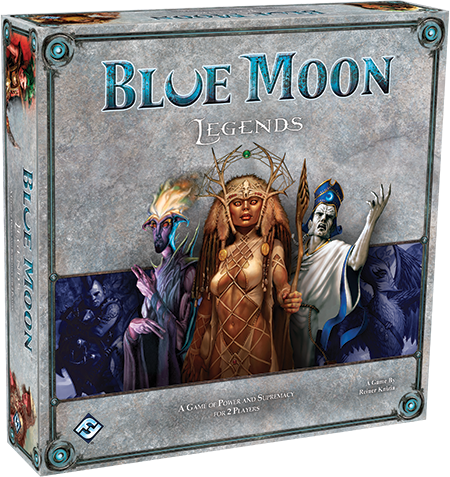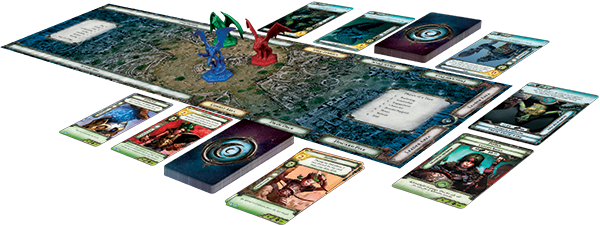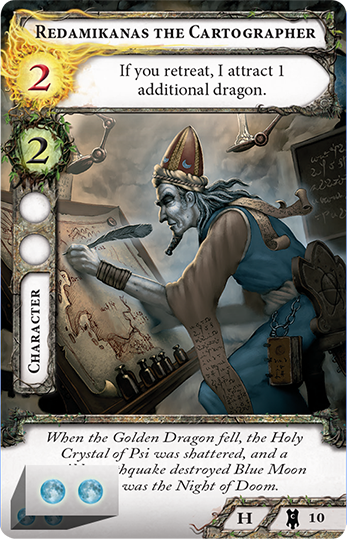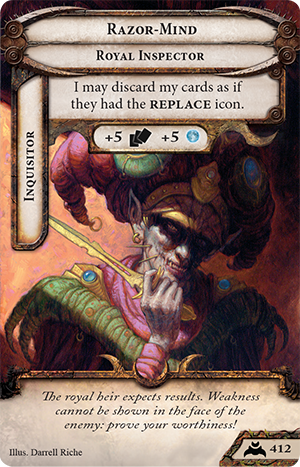
Forge an Empire
Preview Deckbuilding in Blue Moon Legends

The peoples of Blue Moon City were shattered by the death of their king, the disappearance of Blue Moon, and the destruction of the Holy Crystal. Cast far afield by calamities, peoples that once lived in harmony have withdrawn their support from each other, preferring to insulate themselves against potential rivals. But now, two royal heirs have arisen to lead the peoples out of the Night of Doom and into a bright future. Strategic alliances are no longer out of the question.
Blue Moon Legends is a collected version of the Blue Moon card game and its expansions: a fast-paced game for two players, designed by the world-renowned game designer, Reiner Knizia, and first released in 2004. In every game, a player must lead his people to victory by defeating his opponent in a series of challenges. The victor of these challenges attracts the attention of the elemental dragons, the last divine creatures in the world. At the end of the game, whichever player is favored by the elemental dragons becomes the new ruler of Blue Moon City, uniting the peoples once more.
In our previous preview, we examined gameplay in Blue Moon Legends, exploring the structure of challenges and your means for attracting the dragons’ attention. Today, however, we’ll take a closer look at some of your possible options for customizing the core people decks and exploring new ground. We’ll also see the modifications that inquisitors, emissaries, and Buka families can lend to your deck, should you choose to alter the core decks and include them.

Molding an Army
When a player begins building a deck in Blue Moon Legends, he starts by selecting a leader for his people. Your leader determines the predominant composition of your deck – if you select the Vulca leader, Inferno, your deck will consist mostly of Vulca cards. Every leader in Blue Moon Legends requires a deck of exactly thirty cards. The majority of these cards belong to your leader’s people, but every leader has ten moons to spend on out-of-faction cards.
 Most cards in the game possesses a certain number of moons in their lower left hand corner. Cards that do not match your leader’s affiliation may still be convinced to join your deck by using your leader’s influence. For example, if your leader is not the Hoax leader, you may spend two moons to include Redamikanas the Cartographer in your deck. The moons on other factions’ cards count against your leader’s total available moons, but within that limit, you can include cards from any people in your deck.
Most cards in the game possesses a certain number of moons in their lower left hand corner. Cards that do not match your leader’s affiliation may still be convinced to join your deck by using your leader’s influence. For example, if your leader is not the Hoax leader, you may spend two moons to include Redamikanas the Cartographer in your deck. The moons on other factions’ cards count against your leader’s total available moons, but within that limit, you can include cards from any people in your deck.
Every people in Blue Moon Legends has unique strengths, but each also has particular weaknesses. Including cards from other peoples gives you an easy way to shore up those weaknesses. For example, the Pillar feature powerful boosters, supports, and leadership cards, which can greatly shift a challenge in your favor. However, most Pillar characters lack special abilities. Including Redamikanas the Cartographer gives you a way to capitalize on defeating your opponent with the Pillar’s boosters and supports.
Help from the Outside
The leaders of a people can accomplish great things in their quest to reclaim and unite Blue Moon City, but if you choose to customize the core decks, adding aides to your leader might make your army a more focused fighting force. One way you can customize your deck beyond what your leader provides is by adding an inquisitor in your deck. An inquisitor like Razor-Mind, for example, adds five cards to your deck and grants you five more moons for recruiting cards from other peoples. In addition, Razor-Mind gives you the ability to discard cards as if they had the replace icon. This means that instead of playing a leadership card at the beginning of your turn, you may discard a card and draw a new one, allowing you to cycle your deck faster and find the cards you need.
 Other inquisitors support different styles of play. Swift-Fist, for instance, offers neither additional cards nor added moons. Instead, you attract one dragon at the start of the game, giving you an early headstart over your opponent. If you build a deck that plans to rush to victory, Swift-Fist may be worth considering as an inquisitor. On the other hand, an inquisitor like Weave-Tongue gives you both fifteen extra cards in your deck and ten more moons. Weave-Tongue also invites you to draw one additional card during your end phase allowing you to draw the cards you need and opening the doors for you to pack your deck with tools for any situation.
Other inquisitors support different styles of play. Swift-Fist, for instance, offers neither additional cards nor added moons. Instead, you attract one dragon at the start of the game, giving you an early headstart over your opponent. If you build a deck that plans to rush to victory, Swift-Fist may be worth considering as an inquisitor. On the other hand, an inquisitor like Weave-Tongue gives you both fifteen extra cards in your deck and ten more moons. Weave-Tongue also invites you to draw one additional card during your end phase allowing you to draw the cards you need and opening the doors for you to pack your deck with tools for any situation.
If you want to modify your core people decks quickly, there are several pre-constructed options available. The Buka people are a race of sea-faring families, and although they are a completely independent faction on their own, they can also be split into families. These families are easy to add to any existing deck and offer you a variety of ways to boost your deck.
Another way to modify your decks and explore new possibilities is to select an emissary to aid your leader. Each emissary in Blue Moon Legends comes with a selected few cards, allowing you to tap the long-lasting power of the Hyla, raid from the wilderness with the Tutu, or access interference cards that you can play on your opponent’s turn. Adding an emissary to any people’s deck is an easy way to customize a deck and add certain unique cards to your deck.
The Road to Victory
The path to the throne of Blue Moon City is long, but by forging a deck that fits your play style and reaching the limitless deckbuilding options, you can triumph over your opponent. Whether you merge the best parts of two peoples, or rely upon inquisitors, emissaries, and the Buka families to help you, you’ll find all the tools you need in Blue Moon Legends to open the doors to constant replayability. Discuss your ideas for decks in the Blue Moon Legends forums, and pre-order Blue Moon Legends at your local retailer today!
…
